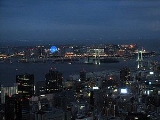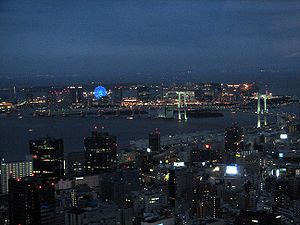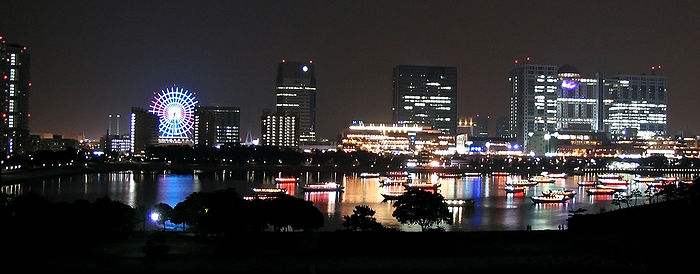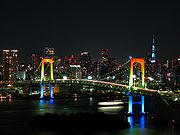
Odaiba
Encyclopedia

Artificial island
An artificial island or man-made island is an island or archipelago that has been constructed by people rather than formed by natural means...
in Tokyo Bay
Tokyo Bay
is a bay in the southern Kantō region of Japan. Its old name was .-Geography:Tokyo Bay is surrounded by the Bōsō Peninsula to the east and the Miura Peninsula to the west. In a narrow sense, Tokyo Bay is the area north of the straight line formed by the on the Miura Peninsula on one end and on...
, Japan
Japan
Japan is an island nation in East Asia. Located in the Pacific Ocean, it lies to the east of the Sea of Japan, China, North Korea, South Korea and Russia, stretching from the Sea of Okhotsk in the north to the East China Sea and Taiwan in the south...
, across the Rainbow Bridge
Rainbow Bridge (Tokyo)
The is a suspension bridge crossing northern Tokyo Bay between Shibaura Pier and the Odaiba waterfront development in Minato, Tokyo, Japan.Construction started in 1987 and was completed in 1993. The bridge is long with a main span of . Officially called the "Shuto Expressway No...
from central Tokyo
Tokyo
, ; officially , is one of the 47 prefectures of Japan. Tokyo is the capital of Japan, the center of the Greater Tokyo Area, and the largest metropolitan area of Japan. It is the seat of the Japanese government and the Imperial Palace, and the home of the Japanese Imperial Family...
. It was initially built for defensive purposes in the 1850s, dramatically expanded during the late 20th century as a seaport district, and has developed since the 1990s as a major commercial, residential and leisure area. Odaiba, along with Minato Mirai 21
Minato Mirai 21
, often shortened to Minato Mirai or MM is a large urban development in Yokohama, Japan. Minato Mirai 21 area is designated for new urban center planned to connect city's traditional center of Kannai and Yokohama Station area....
in Yokohama, are two of the only places in the Greater Tokyo Metropolitan area where the seashore is accessible, and not blocked by industry and harbor areas.
formally refers to one district of the island development in Minato Ward
Minato, Tokyo
is one of the 23 special wards of Tokyo, Japan. As of 1 March 2008, it had an official population of 217,335 and a population density of 10,865 persons per km². The total area is 20.34 km².Minato hosts 49 embassies...
. The Odaiba name is commonly used to refer to the entire which includes the Ariake
Ariake, Tokyo
is a location within Kōtō, Tokyo, Japan. It is best known as the region adjacent to and directly east of Odaiba. Airake is subdivided into four chome and comprises part of the Tokyo Bay Landfill #10 and Tokyo Rinkai Satellite City Center....
and Aomi
Aomi, Tokyo
is a place in Kōtō, Tokyo, Japan. Its subdivisions consist of Aomi 1 and 2 chome. Aomi is part of Tokyo Bay Landfill #13 and Tokyo Rinkai Satellite City Center.Many important facilities are located in Aomi...
districts of Kōtō Ward
Koto, Tokyo
is one of the 23 special wards of Tokyo, Japan. As of 2008, the ward has an estimated population of 442,271 and a population density of 11,070 persons per km². The total area is 39.48 km². The ward refers to itself as Kōtō City in English....
and the Higashi-Yashio district of Shinagawa Ward
Shinagawa, Tokyo
is one of the 23 special wards of Tokyo, Japan. In English, it is called Shinagawa City. The ward is home to nine embassies.As of 2008, the ward has an estimated population of 344,461 and a density of 15,740 persons per km². The total area is 22.72 km²....
.
History

Egawa Hidetatsu
was a Japanese Bakufu intendant of the 19th century. He was Daikan, in charge of the domains of the Tokugawa shogunate in Izu, Sagami and Kai Provinces during the Bakumatsu period...
for the Tokugawa shogunate
Tokugawa shogunate
The Tokugawa shogunate, also known as the and the , was a feudal regime of Japan established by Tokugawa Ieyasu and ruled by the shoguns of the Tokugawa family. This period is known as the Edo period and gets its name from the capital city, Edo, which is now called Tokyo, after the name was...
in order to protect Edo
Edo
, also romanized as Yedo or Yeddo, is the former name of the Japanese capital Tokyo, and was the seat of power for the Tokugawa shogunate which ruled Japan from 1603 to 1868...
from attack by sea, the primary threat being Commodore Matthew Perry
Matthew Perry (naval officer)
Matthew Calbraith Perry was the Commodore of the U.S. Navy and served commanding a number of US naval ships. He served several wars, most notably in the Mexican-American War and the War of 1812. He played a leading role in the opening of Japan to the West with the Convention of Kanagawa in 1854...
's Black Ships which had arrived in the same year. Daiba in Japanese
Japanese language
is a language spoken by over 130 million people in Japan and in Japanese emigrant communities. It is a member of the Japonic language family, which has a number of proposed relationships with other languages, none of which has gained wide acceptance among historical linguists .Japanese is an...
refers to the cannon batteries placed on the islands. In 1928, the Dai-San Daiba (第三台場) or "No. 3 Battery" was refurbished and opened to the public as the Metropolitan Daiba Park, which remains open to this day.

Port of Tokyo
Port of Tokyo is one of the largest Japanese seaports and one of the largest seaports in the Pacific Ocean basin having an annual traffic capacity of around 100 million tonnes of cargo and 4,500,000 TEU's....
opened in 1941. Until the mid 1960s all except two batteries were either removed for unhindered passage of ships or incorporated into the Shinagawa port facilities and Tennozu island. In 1979 the then called landfill no. 13 (now Minato-ku
Minato, Tokyo
is one of the 23 special wards of Tokyo, Japan. As of 1 March 2008, it had an official population of 217,335 and a population density of 10,865 persons per km². The total area is 20.34 km².Minato hosts 49 embassies...
Daiba, Shinagawa-ku
Shinagawa, Tokyo
is one of the 23 special wards of Tokyo, Japan. In English, it is called Shinagawa City. The ward is home to nine embassies.As of 2008, the ward has an estimated population of 344,461 and a density of 15,740 persons per km². The total area is 22.72 km²....
Higashi-Yashio and Kōtō-ku
Koto, Tokyo
is one of the 23 special wards of Tokyo, Japan. As of 2008, the ward has an estimated population of 442,271 and a population density of 11,070 persons per km². The total area is 39.48 km². The ward refers to itself as Kōtō City in English....
Aomi
Aomi, Tokyo
is a place in Kōtō, Tokyo, Japan. Its subdivisions consist of Aomi 1 and 2 chome. Aomi is part of Tokyo Bay Landfill #13 and Tokyo Rinkai Satellite City Center.Many important facilities are located in Aomi...
districts), was finished directly connecting with the old "No. 3 Battery". "No. 6 Battery" was left to nature (landing prohibited).
Tokyo governor Shunichi Suzuki began a major development plan in the early 1990s to redevelop Odaiba as Tokyo Teleport Town, a showcase for futuristic living, with new residential and commercial development housing a population of over 100,000. The redevelopment was scheduled to be complete in time for a planned "International Urban Exposition" in spring 1996.
Suzuki's successor Yukio Aoshima
Yukio Aoshima
was a Japanese politician who served as a Governor of Tokyo Metropolitan Government from 1995 to 1999. He is also well known as a novelist, a film director and a TV-actor.- Early life :...
halted the plan in 1995, by which point over JPY
Japanese yen
The is the official currency of Japan. It is the third most traded currency in the foreign exchange market after the United States dollar and the euro. It is also widely used as a reserve currency after the U.S. dollar, the euro and the pound sterling...
1 trillion had been spent on the project, and Odaiba was still underpopulated and full of vacant lots. Many of the special companies set up to develop the island became practically bankrupt. The collapse of the Japanese asset price bubble
Japanese asset price bubble
The was an economic bubble in Japan from 1986 to 1991, in which real estate and stock prices were greatly inflated. The bubble's collapse lasted for more than a decade with stock prices initially bottoming in 2003, although they would descend even further amidst the global crisis in 2008. The...
was a major factor, as it frustrated commercial development in Tokyo generally. The area was also viewed as inconvenient for business, as its physical connections to Tokyo—the Rainbow Bridge
Rainbow Bridge (Tokyo)
The is a suspension bridge crossing northern Tokyo Bay between Shibaura Pier and the Odaiba waterfront development in Minato, Tokyo, Japan.Construction started in 1987 and was completed in 1993. The bridge is long with a main span of . Officially called the "Shuto Expressway No...
and the Yurikamome
Yurikamome
, formally the is an automated guideway transit service operated by the Tokyo Waterfront New Transit Corporation, connecting Shimbashi to Toyosu, passing through the artificial island of Odaiba in Tokyo, Japan, a market in which it competes with the cheaper Rinkai Line.The line is named after the...
rapid transit line—made travel to and from central Tokyo relatively time-consuming.
The area started coming back to life in the late 1990s as a tourist and leisure zone, with several large hotels and shopping malls. Several large companies including Fuji Television
Fuji Television
is a Japanese television station based in Daiba, Minato, Tokyo, Japan, also known as or CX, based on the station's callsign "JOCX-DTV". It is the flagship station of the Fuji News Network and the ....
moved their headquarters to the island, and transportation links improved with the connection of the Rinkai Line
Tokyo Waterfront Railway
is a third-sector company that owns and operates the Rinkai Line. The company was founded on March 12, 1991 for the express purpose of constructing and operating the railway line, which connects central Tokyo with Odaiba...
into the JR East railway network in 2002 and the eastward extension of the Yurikamome to Toyosu in 2006. Tokyo Big Sight
Tokyo Big Sight
is the popular nickname for the , a Japanese convention center that opened in April 1996. Located in Odaiba, Tokyo Bay, the center is one of the largest convention venues within the city, and its most iconic representation is the visually distinctive Conference Tower.-Construction:Contracted by the...
, the convention center originally built to house Governor Suzuki's planned intercity convention, also became a major venue for international expositions.

Attractions


- Palette Town:
- DaikanranshaDaikanranshais a tall Ferris wheel at Palette Town in Odaiba, Tokyo, Japan.When it opened in 1999, it was the world's tallest Ferris wheel. It has the same diameter as its world record predecessor, the Tempozan Ferris Wheel, at Osaka, but its overall height is greater...
, a 115 metres (377 ft) Ferris wheelFerris wheelA Ferris wheel is a nonbuilding structure consisting of a rotating upright wheel with passenger cars attached to the rim in such a way that as the wheel turns, the cars are kept upright, usually by gravity.Some of the largest and most modern Ferris wheels have cars mounted on... - Zepp TokyoZeppThe Zepp music halls are a group of Japanese music halls covering every area of the country. The Zepp halls play host to many international tours and are a popular stop among Japanese musicians. Each venue takes the Zepp name, along with the city in which it is located...
, one of Tokyo's largest performance halls/nightclubs - Megaweb, exhibition hall of car maker Toyota
- Tokyo Leisure Land, 24 hour video gaming, karaokeKaraokeis a form of interactive entertainment or video game in which amateur singers sing along with recorded music using a microphone and public address system. The music is typically a well-known pop song minus the lead vocal. Lyrics are usually displayed on a video screen, along with a moving symbol,...
, bowlingBowlingBowling Bowling Bowling (1375–1425; late Middle English bowle, variant of boule Bowling (1375–1425; late Middle English bowle, variant of boule... - Venus Fort, a VeniceVeniceVenice is a city in northern Italy which is renowned for the beauty of its setting, its architecture and its artworks. It is the capital of the Veneto region...
-themed shopping mall
- Daikanransha
- Fuji TelevisionFuji Televisionis a Japanese television station based in Daiba, Minato, Tokyo, Japan, also known as or CX, based on the station's callsign "JOCX-DTV". It is the flagship station of the Fuji News Network and the ....
studios with a distinctive building designed by Kenzo TangeKenzo Tangewas a Japanese architect, and winner of the 1987 Pritzker Prize for architecture. He was one of the most significant architects of the 20th century, combining traditional Japanese styles with modernism, and designed major buildings on five continents. Tange was also an influential protagonist of... - MiraikanMiraikanis Japan's National Museum of Emerging Science and Innovation, created by Japan's Science and Technology Agency. It is situated in a new purpose-built building in the Odaiba District of Tokyo. Some highlights include real-time displays of data from a huge array of seismometers across Japan which...
, Japan's National Museum of Emerging Science and Innovation - Rainbow BridgeRainbow Bridge (Tokyo)The is a suspension bridge crossing northern Tokyo Bay between Shibaura Pier and the Odaiba waterfront development in Minato, Tokyo, Japan.Construction started in 1987 and was completed in 1993. The bridge is long with a main span of . Officially called the "Shuto Expressway No...
connecting Odaiba to the heart of Tokyo - Tokyo Big SightTokyo Big Sightis the popular nickname for the , a Japanese convention center that opened in April 1996. Located in Odaiba, Tokyo Bay, the center is one of the largest convention venues within the city, and its most iconic representation is the visually distinctive Conference Tower.-Construction:Contracted by the...
Tokyo International Exhibition Center - Aqua City shopping center
- Decks Tokyo Beach shopping mall, featuring Sega JoypolisJoypolisJoypolis is an amusement park that was first opened on July 20, 1994 in Yokohama, Japan. Joypolis centres have since opened in several cities in Japan with the parks featuring arcade games and amusement rides based on Sega intellectual properties...
and Little Hong Kong - Museum of Maritime Science (Fune no kagakukan) with swimming pool
- Oedo-Onsen-Monogatari sentōSentois a type of Japanese communal bath house where customers pay for entrance. Traditionally these bath houses have been quite utilitarian, with one large room separating the sexes by a tall barrier, and on both sides, usually a minimum of lined up faucets and a single large bath for the already...
- Shiokaze park with BBQ places and Higashi Yashio park
- Telekom Center Building (MXTV'sTokyo Metropolitan Televisionthumb|Tokyo Metropolitan Television old headquarters : Telecom Center Building is the only commercial television station in Tokyo, Japan that exclusively serves the city. It competes with Nippon Television, TV Asahi, Tokyo Broadcasting System, TV Tokyo, and Fuji Television, all of which are...
former headquarters) with observation deck - One of two beaches in urban Tokyo (swimming prohibited), along with Kasai Rinkai ParkKasai Rinkai ParkKasai Rinkai Park is a park in Edogawa, Tokyo, Japan, which officially opened on June 1, 1989. The park includes an aquarium and a bird sanctuary, and was built on reclaimed land which includes two manmade islands, a viewing tower and a hotel.The tall Diamond and Flower Ferris Wheel opened at the...
in Edogawa WardEdogawa, Tokyois one of the 23 special wards of Tokyo, Japan. It takes its name from the river that runs from north to south along the eastern edge of the ward. In English, it uses the name Edogawa City.... - A replica of the Statue of Liberty
- Panasonic Centre, a science and technology showroom
Transport
Two Shuto ExpresswayShuto Expressway
is a network of toll expressways in the Greater Tokyo Area of Japan. It is operated and maintained by the .Most routes consist of elevated roadway above other roads or over water, and have many sharp curves which require caution to drive safely...
lines access Odaiba: Route 11 enters from central Tokyo crossing the Rainbow Bridge
Rainbow Bridge (Tokyo)
The is a suspension bridge crossing northern Tokyo Bay between Shibaura Pier and the Odaiba waterfront development in Minato, Tokyo, Japan.Construction started in 1987 and was completed in 1993. The bridge is long with a main span of . Officially called the "Shuto Expressway No...
, while the Wangan Route
Bayshore Route
Wangan has many meanings. See Wangan for a list.The Bayshore Route of Shuto Expressway is a stretch of toll highway in Greater Tokyo, 70 km, that runs from Yokohama city, Kanazawa ward, to Ichikawa city of Chiba Prefecture...
enters from Shinagawa Ward through the Tokyo Port Tunnel and from the bayfront areas of Tokyo and Chiba Prefecture
Chiba Prefecture
is a prefecture of Japan located in the Kantō region and the Greater Tokyo Area. Its capital is Chiba City.- History :Chiba Prefecture was established on June 15, 1873 with the merger of Kisarazu Prefecture and Inba Prefecture...
to the east.
By public transport Odaiba is accessible via the automated Yurikamome
Yurikamome
, formally the is an automated guideway transit service operated by the Tokyo Waterfront New Transit Corporation, connecting Shimbashi to Toyosu, passing through the artificial island of Odaiba in Tokyo, Japan, a market in which it competes with the cheaper Rinkai Line.The line is named after the...
transit system from Shimbashi
Shimbashi Station
is a major interchange station in Tokyo's Minato Ward. Located centrally and a 10-minute walk from the Ginza shopping district, directly south of Tokyo station.-History:...
and Toyosu
Toyosu Station
Toyosu Station is the name given to two train stations in Kōtō, Tokyo, Japan. The metro station opened on June 8, 1988, and serves the Tokyo Metro Yūrakuchō Line. Adjacent to the metro station, above ground, is the eastern terminus of the Yurikamome Line , which was extended to Toyosu on March...
. The privately-operated Rinkai Line
Rinkai Line
The is a railway line located in Tokyo, Japan. It is the only line operated by the third-sector company Tokyo Waterfront Area Rapid Transit. It connects central Tokyo to the artificial islands of Aomi and Odaiba...
runs between Shin-Kiba
Shin-Kiba Station
is a railway station in Kōtō, Tokyo, Japan.-Lines:Shin-Kiba Station is served by the following lines:* Keiyō Line * Tokyo Metro Yūrakuchō Line * Rinkai Line -JR East platforms:-Tokyo Metro platforms:...
and Ōsaki
Osaki Station
is a railway stationin Tokyo's Shinagawa Ward. It is one of the stations where trains on the Yamanote Line loop are put into and taken out of service...
but many trains connect directly to Shibuya
Shibuya Station
is a train station located in Shibuya, Tokyo, Japan. With 2.4 million passengers on an average weekday in 2004, it is the fourth-busiest commuter rail station in Japan handling a large amount of commuter traffic between the center city and suburbs to the south and west.-JR East:*Saikyō Line /...
, Shinjuku
Shinjuku Station
is a train station located in Shinjuku and Shibuya wards in Tokyo, Japan.Serving as the main connecting hub for rail traffic between central Tokyo and its western suburbs on inter-city rail, commuter rail and metro lines, the station was used by an average of 3.64 million people per day in 2007,...
, and Ikebukuro
Ikebukuro Station
is a railway station located in the Ikebukuro district of Toshima, Tokyo, Japan. With 2.71 million passengers on an average daily in 2007, it is the second-busiest train station in the world , and the busiest station in the Tobu, Seibu and Tokyo Metro networks. It primarily serves commuters from...
. City buses provide cheaper if slower access. Ferries connect Odaiba with Asakusa
Asakusa
is a district in Taitō, Tokyo, Japan, most famous for the Sensō-ji, a Buddhist temple dedicated to the bodhisattva Kannon. There are several other temples in Asakusa, as well as various festivals.- History :...
running along the Sumida River
Sumida River
The is a river which flows through Tokyo, Japan. It branches from the Arakawa River at Iwabuchi and flows into Tokyo Bay. Its tributaries include the Kanda and Shakujii rivers....
and the Kasai Rinkai Park
Kasai Rinkai Park
Kasai Rinkai Park is a park in Edogawa, Tokyo, Japan, which officially opened on June 1, 1989. The park includes an aquarium and a bird sanctuary, and was built on reclaimed land which includes two manmade islands, a viewing tower and a hotel.The tall Diamond and Flower Ferris Wheel opened at the...
in eastern Tokyo.
External links
- Wikitravel
- Area Guide of Odaiba with sightseeing spots
- historical map from 1892 (in Japanese)

